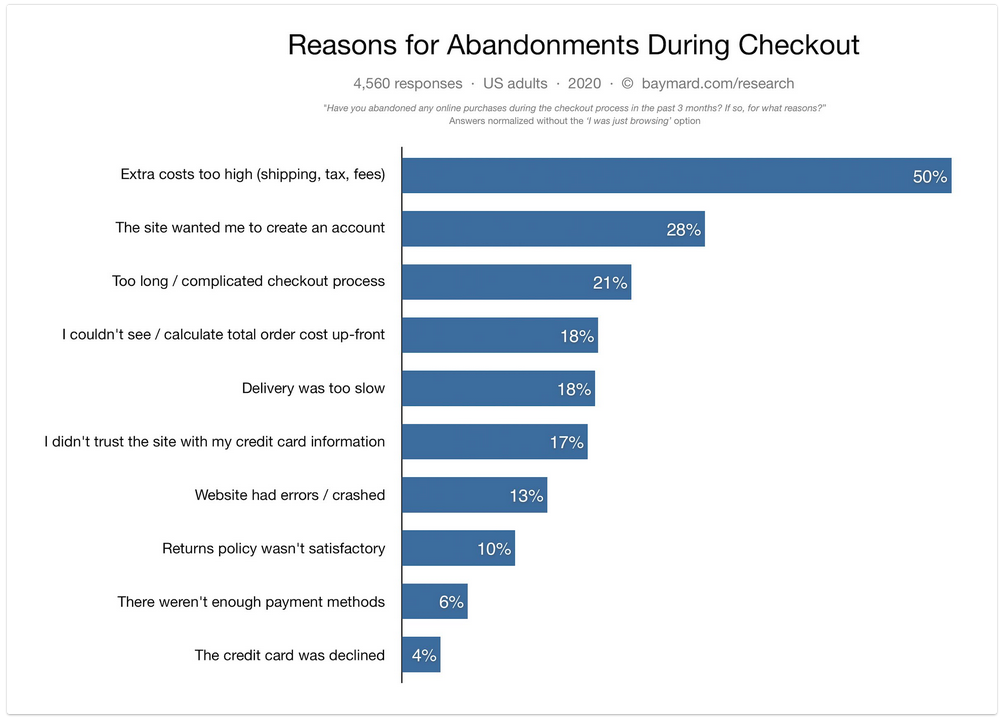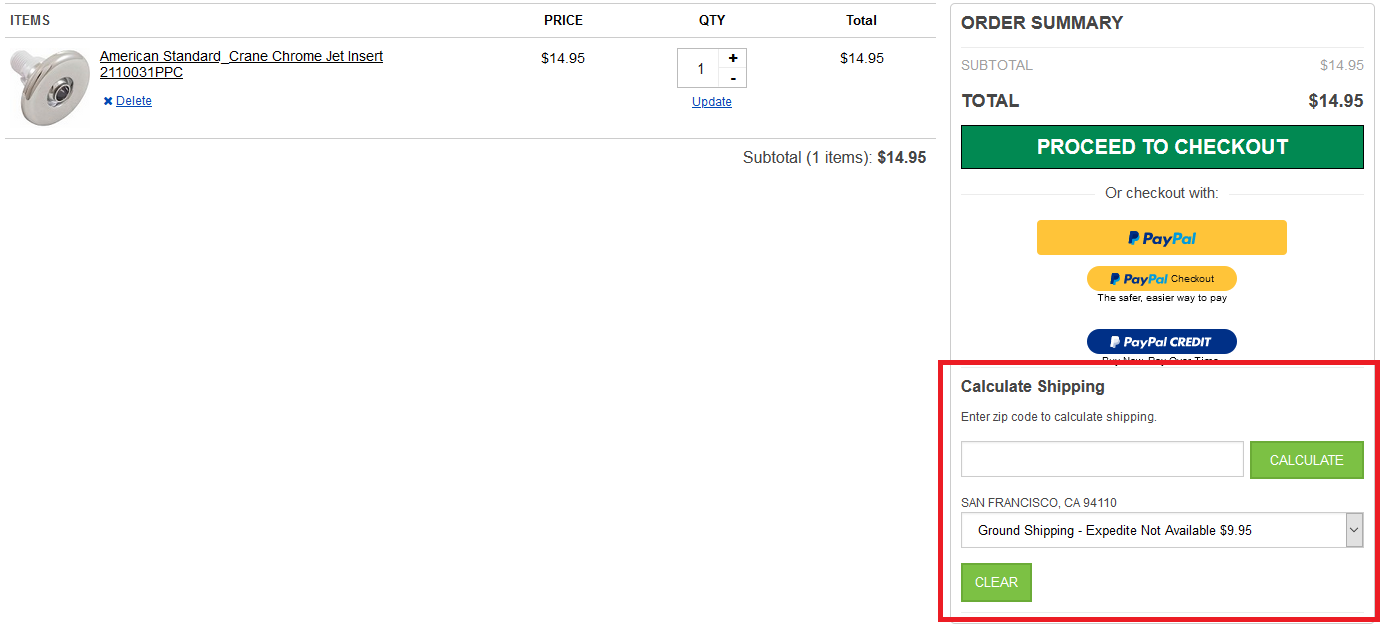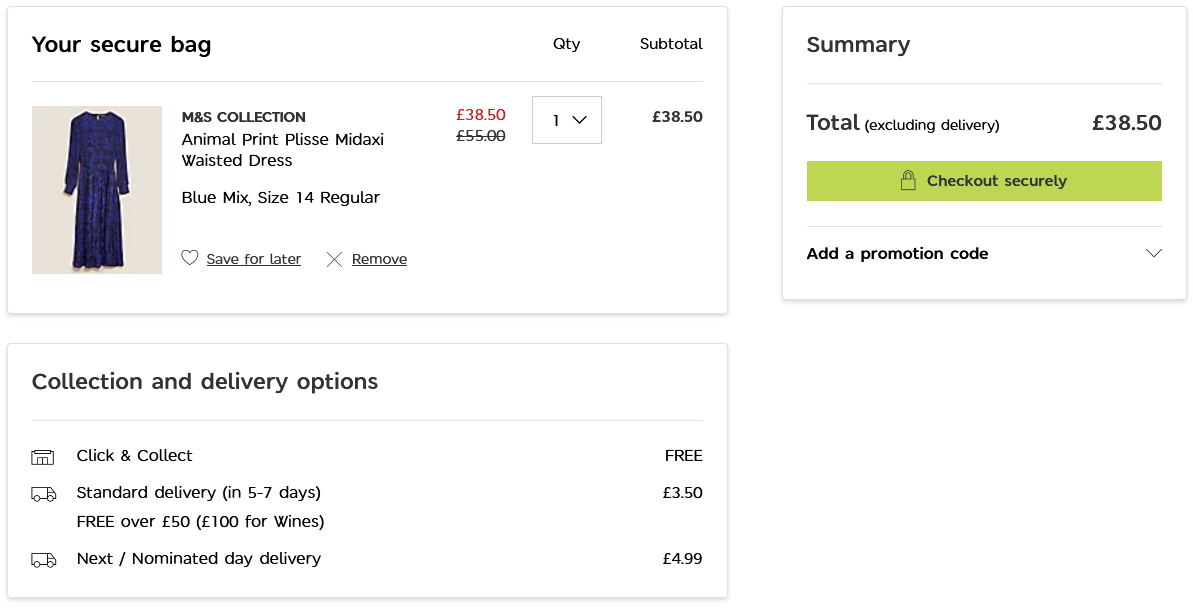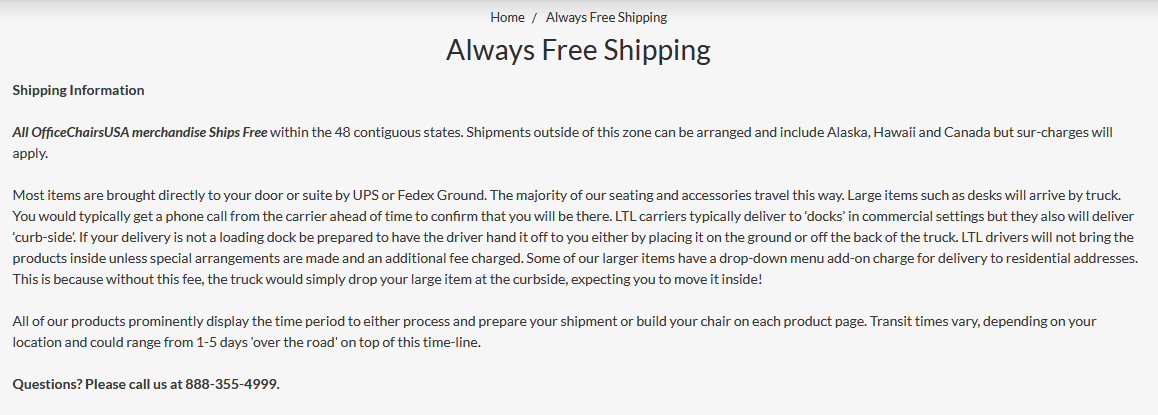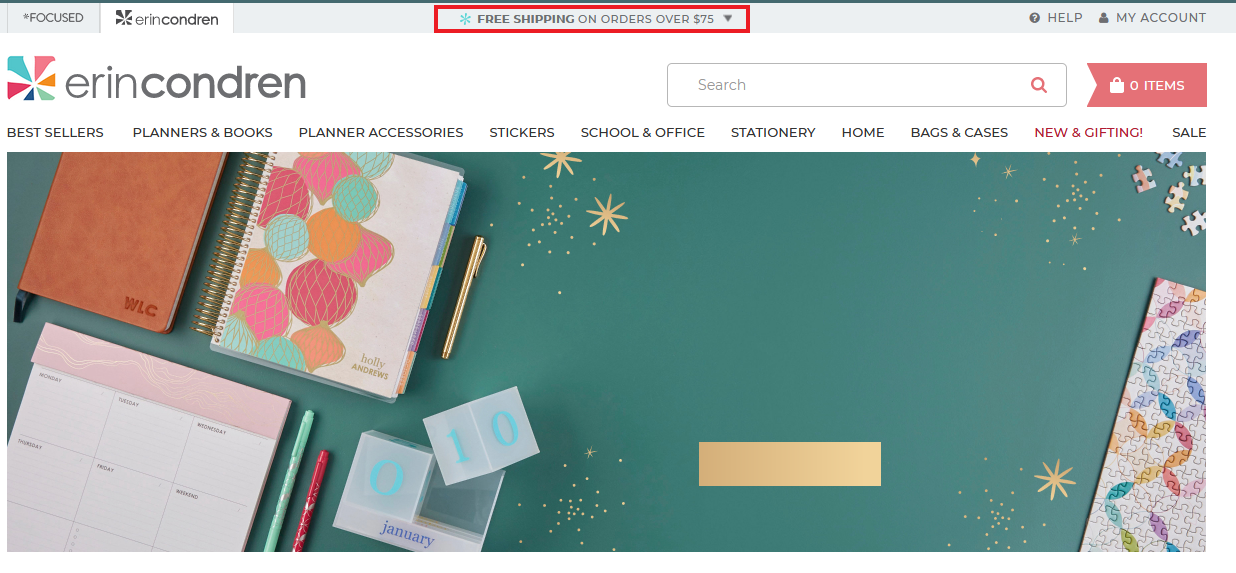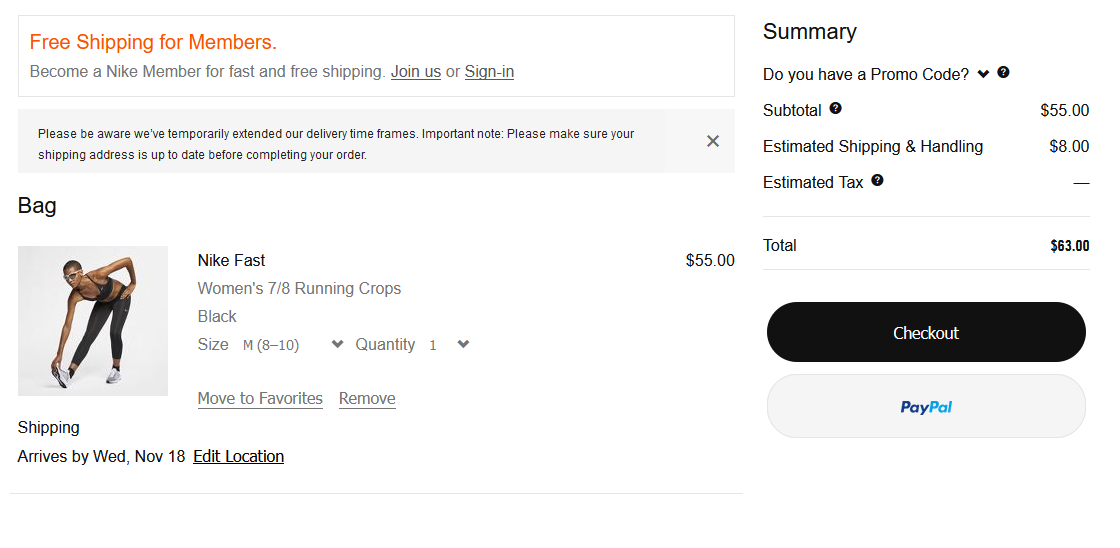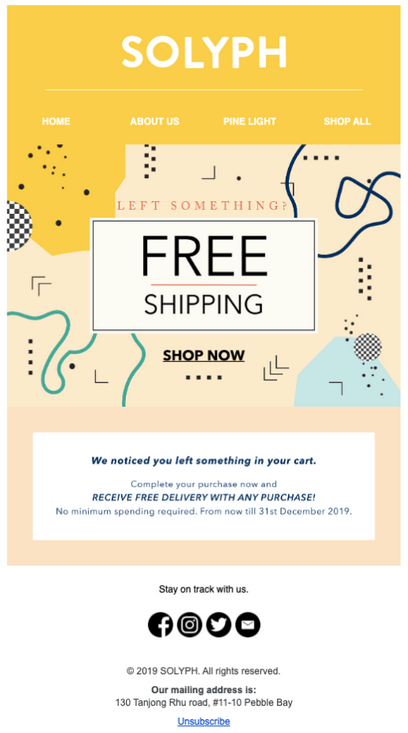Shopping cart abandonment – where customers put items in their cart but fail to check out – is a phenomenon that all e-commerce retailers have to deal with. Cart abandonment rates vary across niches, but a study from the Baymard Institute found that the overall average rate is about 70%. That’s a lot of potential sales you might be missing out on!
It is impossible to eliminate cart abandonment altogether. It is a fact of life in the e-commerce game. Fortunately, there is plenty of research into factors that cause cart abandonment and steps you can take to reduce it.
In this article, we’ll look at one such factor: shipping rates. Read on to learn about the relationship between cart abandonment rate and shipping, and how you can mitigate the problem to close as many sales as possible.
Let’s jump in.
Shopping cart abandonment rate and shipping: the relationship
The Baymard Institute study into shopping cart abandonment also investigated the reasons that people abandon their purchases before checking out. The number one reason? Hidden extra costs, including shipping:
Research of Sendcloud also shows that 65% of the European consumers leave a checkout, because the stated shipping costs are too high.
Think about it: when you decide to purchase an item online, you understand that you may have to pay a small extra cost for shipping. But if that cost is unclear, or too high, you’ll think twice about making the purchase. That’s why a large majority of shopping carts are abandoned due to high shipping costs.
Another common and related reason customers choose to abandon their purchase is that their items do not meet the threshold for free shipping.
The bottom line is clear: shipping is a huge factor when it comes to cart abandonment. So if your store is seeing an above-average number of abandoned carts, your shipping and handling fees might well be a part of the problem. In the next section, we’ll look at a few ways you can correct the problem and increase the percentage of your customers who push through and complete their purchase.
How to address shipping as a cart abandonment factor
Since we’ve established that shipping is the leading cause of abandoned shopping carts in e-commerce stores, you’ll want to prioritize addressing it. Fortunately, there are numerous easy ways to mitigate the problems shipping can cause.
Let’s look at a few simple fixes you can make that should give your completed sales figures a boost.
Update shipping costs in real time
When customers add items to their shopping cart in an e-commerce store, they expect the price they see to be the price they’ll actually pay. One of the easiest ways you can mitigate the issue of abandoned carts due to surprise shipping costs is to update those costs on the shopping cart page in real time. Your e-commerce platform should give you the option to add this functionality.
One of the easiest ways to do this is to add a box for customers to enter their Zip or postal code, and add on shipping automatically. Here’s how Spacare, one of the clients of Shift4Shop, does it:
Offer more than one shipping option
Customers like to have a choice. For example, you might offer a standard shipping rate, or allow the customer to pay a higher rate for next-day delivery if they need their items quickly. While many people will be happy to wait a few days for their items and pay a lower shipping rate, others will happily pay more for quick delivery. There’s a reason Amazon’s Prime service is so popular!
Perhaps you can offer a choice of delivery services or couriers, too – if you only offer FedEx, for example, a customer who has had a bad experience with FedEx in the past is far less likely to buy from you. If you have brick-and-mortar stores, click and collect is an increasingly popular option, too.
If you offer different shipping options, you can also display all of them on the shopping cart page so customers can see what their choices are. Here’s how Marks & Spencer, a British clothing and homewares retailer, does this:
By allowing customers to see shipping costs at a glance on their shopping cart page, you eliminate the risk of any nasty surprises when they come to check out.
Find out more about how to combine carriers, shipping methods and optimizing your e-commerce logistics here.
Disclose any handling fees upfront
Do you charge any handling fees on online orders? If so, it’s best to disclose these to your customers upfront. If you don’t, they’re likely to become annoyed and close the window without checking out. Hidden fees leave a bad taste in customers’ mouths as they can feel as though you’re not being honest with them.
Remember that handling charges are separate from delivery costs. Handling can include things like the time it takes your staff to pick and package the order, extra packing materials for fragile items, and so on. Extra handling charges might be applicable in cases where assembly is required before delivery, the item is gift-wrapped, or there is some form of customization.
Always present the handling fee separately from the shipping charge, and disclose it upfront to the customer on the shopping cart page. If customers can see what they’ll pay at a glance, they’re far less likely to abandon their cart.
Offer free shipping
It sounds obvious, but many ecommerce retailers underestimate the power of free shipping. This strategy tends to make the most sense if you are selling high ticket items or have a high average order value (AOV). In these cases, any costs you incur from shipping will be far outweighed by the large profit margin on your products. It will also encourage customers to keep coming back and to choose you over your competitors.
Office Chairs USA is one company that offers free shipping on everything:
Since the company sells mostly high value items that cost hundreds to thousands of dollars, we can safely assume its high AOV is such that any costs associated with this generous shipping policy are offset.
Cut your free shipping threshold
It might not be practical or make financial sense for you to offer free shipping on all orders. This is particularly true if you sell a high volume of low-value items, where the cost of shipping might negate the value of the order if you offered shipping for free. However, I always recommend having a threshold at which shipping becomes free. If you don’t, customers will be far less likely to place higher-value orders with you.
If you’re seeing a lot of abandoned carts, one problem might be that your free shipping threshold is too high. Why not reduce it and see what happens? Try to set it at a point where most customers will be able to reach it, while still boosting your AOV. To do this, work out your AOV (total number of orders / total revenue = AOV), and then set your free shipping threshold just slightly above that number.
Pro tip: if you offer free shipping over a certain order threshold, advertise that fact prominently. In the above example, stationery and office supplies retailer Erin Condren offers free shipping on purchases over $75, and advertises that fact on its homepage header.
Offer free shipping for members, subscribers, or VIPs
Why not create a system where customers can earn free shipping on their orders while also having a marketing benefit for you? One of the best ways to do this is to set up a membership scheme, VIP club, or email newsletter. You can then offer subscribers free shipping as a perk of membership.
Sportswear retailer Nike has a free membership scheme which offers a host of benefits, including free shipping on all orders. This information is displayed prominently on its shopping cart page:
Free shipping is a highly desirable perk. If you offer it to members and subscribers, you not only decrease the risk of cart abandonment at checkout, but you also add new customers to your email list and digital marketing funnel.
Offer free shipping as part of a cart abandonment email sequence
An abandoned cart email sequence is a series of emails you send to customers when they have abandoned a shopping cart, encouraging them to come back to your site and check out. It’s a hugely effective strategy – according to Moosend, 45% of shopping cart abandonment emails are opened. 50% of the opened emails receive click throughs, and 50% of those clicks result in a purchase.
In other words, if you’re not already using cart abandonment sequences, you’re missing out on potential sales. One of the best ways to encourage customers to come back to your store and finish their purchase? Offer them a limited-time free shipping deal!
You don’t necessarily have to do this on the first email. It can sometimes be more powerful if you leave it until the second email in the sequence (the first should be a simple reminder in case the customer simply forgot to check out or got distracted). Whenever you make the offer, ensure it’s time-limited. This creates a sense of FOMO (fear of missing out) and nudges the customer to take action. Here’s how skincare company Solyph did it:
Notice that the free shipping offer is the most central and prominent part of the email, and that the offer is clearly defined and time-limited. If the customer abandoned their cart due to high shipping costs, this is very likely to spur them to complete their purchase.
In closing
Shopping cart abandonment is a real issue in the ecommerce game, and it’s something all of us have to contend with if we want to sell products online. If your cart abandonment rate is below average for your industry – well done! If not, you’ll want to start looking at things you can amend and tweak to increase your conversions and lower your number of abandoned carts.
There is a real relationship between shopping cart abandonment rate and shipping. In fact, shipping issues are the most common reason customers abandon their shopping carts in ecommerce stores. Fortunately, there are a few easy steps you can take.
In summary, my top tips are as follows:
- Allow customers to see their shipping costs at a glance on the shopping cart page
- Offer several shipping options at different price-points and using different carriers
- Disclose any handling fees early and transparently
- Offer free shipping if it makes financial sense to do so
- Cut your free shipping threshold to entice more customers to make the most of it
- Create a members’ or subscribers’ free shipping offer
- Use cart abandonment email sequences and include free shipping as an offer to entice the customer to complete their purchase
Remember that improving your conversion rates and lowering cart abandonment is an ongoing challenge. You can’t expect to get it right immediately. Try things out, see what works, and run A/B tests to evaluate which strategies are most effective.
Good luck!
About the author
Jimmy Rodriguez is the COO and co-founder of Shift4Shop, an ecommerce software to build SEO-friendly online stores. He’s dedicated to helping internet retailers succeed online by developing digital marketing strategies and optimized shopping experiences that drive conversions and improve business performance.

